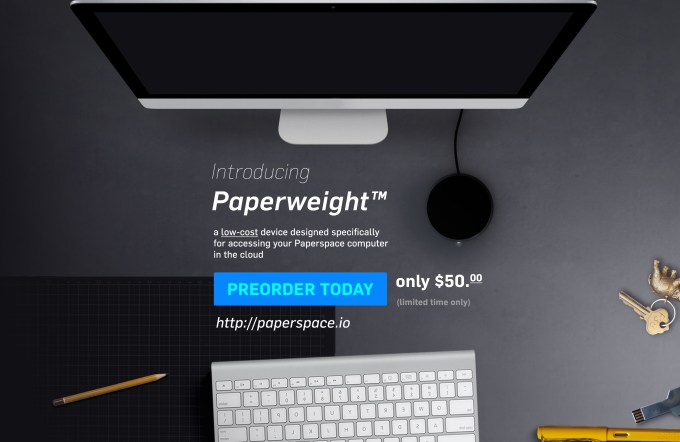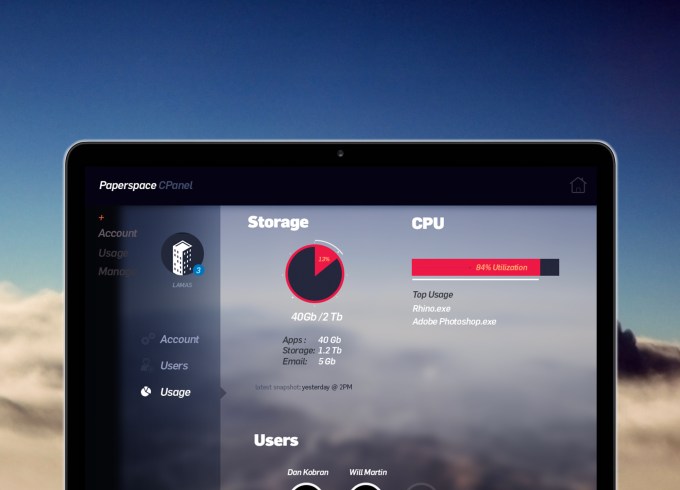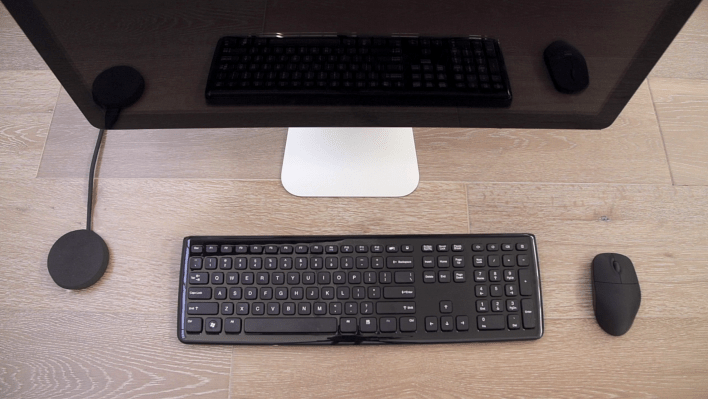Imagine never having to buy new and expensive hardware to upgrade your personal computer with more speed and storage space. That’s the vision behind Y Combinator-backed Paperspace, a new company launching today, which is building a full, personal computer that lives in the cloud, which you access from any web browser. Similar, to some extent, to enterprise-grade solutions like VMWare, Citrix or Amazon Workspaces, but aimed also at a consumer or “prosumer” audience, the company is selling a small hardware device that plugs into any older desktop or laptop in order to provide you with the computing power you need on demand.
Called Paperweight, this low-cost hardware device connects you with your own remote machine on Paperspace’s servers, where you can choose from either a “basic” or “pro” option based on your computing needs. The device is considered a “zero client,” because unlike thin client technology, there’s only a small microprocessor on the inside – all the processing is taking place on the cloud.
Today, there are number of solutions for accessing computing power via the cloud thanks to companies like Amazon and others, but these services require users to be more technical in order to get started. Paperspace is different because it’s aiming to wrap up a similar service in terms of accessing a remote, cloud computer, but offering it through an easy-to-use console where everyday consumers can just click a button to log into their upgraded, more powerful remote machine.

Co-founders Dillon Thompson Erb and Dan Kobran say they came up with the idea for Paperspace while developing technology applications and deployments in the architecture industry while at the University of Michigan.
In order to run some simulations they needed to buy an expensive, “beast” of a computer – and even then, the simulations took days to run. “We started looking into cloud computing because it was becoming big in the scientific computing world,” explains Erb. “And then we started exploring how we could make it much easier to use because it’s really difficult to get going.”
He says that he and Kobran were comfortable with the process of using the solutions available today, which involved going to the command line at times, but most people are not.
“[This technology] is accessible to big enterprise companies and really technical people – but everyone else is left out,” Erb notes.

Initially, the idea was to target the “prosumer” audience with Paperspace – that is, anyone who needs additional processing power on demand in an easy-to-use interface. This includes students, hobbyists, as well as creative professionals in need of running simulations, rendering, 3D CAD, or doing photo and video editing, for example. They also saw that it may make sense for developers or those in need of multiple operating systems, who may today run things like Parallels, Fusion or Bootcamp. Or it could serve to meet the needs of anyone who felt their time may be better spent actually working, rather than setting up remote machines.
But there’s a broader market that could be served, too, the founders have since realized, as a simple interface could mean schools could update outdated computer labs, and even enterprise customers may want to use its devices because they’re cheaper than buying regular computers, and they’re easier for employees to use. In a way, the company sees Paperspace as being the cloud computing equivalent to something like how Dropbox simplified file-sharing – which had been possible for years through solutions like FTP, for instance, but never clicked with consumers until it was better designed and made easy to use.

The benefits of using a cloud computer like Paperspace’s isn’t only access to the processing power, but also the ability to run desktop programs which you can’t do on Google’s web-based Chromebook, for example, as well as do things like transfer large files instantly, or quickly screen share by streaming your display.
The idea, however, is not to compete directly with Amazon Web Services and the like in the data center, but rather focus on making virtualization technology accessible to more people by way of an improved design and user interface.
“The software is agnostic,” says Erb. “There’s nothing that we have in our software now that requires us to run on any certain stack…the actual VM itself – the instance – it doesn’t really matter where it is. It could be Amazon, it could be Google,” he says. Instead, the service is about leveraging the hardware as a commodity.
“We’re tying to make the software…we’re not really caring about the hardware,” says Erb. “We’re like a thin layer on top.”
The founders built the first version of Paperspace using Amazon, but are currently using off-the-shelf server components, including cloud orchestration software Xen and Nvidia GRID. But they’re still testing different solutions, they say. They’ve also bought space in a colocation center for right now, though eventually they would like to build their own data center.
And unlike with traditional methods of remote access like VNC or Microsoft’s remote desktop protocol RDP, Paperspace can run full HD content directly in the client by taking advantage of new web technologies like Websockets, WebGL, and asm.js on the client side.
Basically, the founders tell us, if your machine can stream a movie from Netflix, it’s capable of running Paperspace, too.
The service itself will be sold for $10 per month (for the basic service) and up, with different tiers available. (Pricing TBD.) Today, you can access either a Windows 7 or 8 machine or an Ubuntu installation, but support for other operating systems, including Mac OS X, are planned. And you can upgrade or downgrade from the basic or pro level service any month you choose, while still retaining your current customizations and settings.
The Paperweight device is available for pre-order starting today for $50 for a limited time, and TechCrunch readers can take $5 off using the coupon code TECHCRUNCH for the first 250 purchases. The devices will ship in late 2015.
Paperspace is a self-funded company, outside of an investment from Y Combinator, and is a distributed team of seven.
